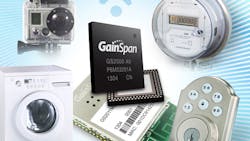GainSpan’s GS2000 incorporates ZigBee/802.15.4 and Wi-Fi radios, enabling a single-chip solution that talks to electric meters and a wide variety of appliances and other devices in a home-area network.
GainSpan’s GS2000 multimode system-on-chip (SoC) implements Wi-Fi and 802.15.4/ZigBee radios in a single IC with an ARM microcontroller along with memory, multiple interfaces, and I/O capabilities. It targets the home automation market (see the figure).
Home automation and energy management products rely on communications networks to provide expected monitoring and control functions. ZigBee wireless technology has made some inroads with electric meter manufacturers. Other technologies like power-line communications, Wi-Fi, and Z-Wave have also seen some action.
Now, two trends are pushing the home automation movement toward a singular solution. First, the Internet of Things (IoT) is leading manufacturers to adopt Internet protocol (IP) addressing schemes that some wireless devices do not support. Second, appliance manufacturers seem to have settled on Wi-Fi as the communications link for future refrigerators, washers, driers, and other white goods.
Given these trends and Wi-Fi’s use in many homes for Internet access, it makes sense to choose Wi-Fi as the anchor for new home automation implementations. However, devices still need to be flexible enough to implement all the technologies that are likely to appear in future home networks.
The GS2000 fully integrates multi-standard RF as well as both 802.11b/g/n and 802.15.4 physical layer/media access controller (PHY/MAC) functionality, dual ARM Cortex M3 CPUs, a networking stack and services, and a large memory to support various application profiles. The 802.15.4/ZigBee feature talks to the electric meter and any other ZigBee-enabled device, while the Wi-Fi 802.11 radio talks to the appliances, the home router, and other Wi-Fi devices.
A dual-mode IPv4/IPv6 TCP/UDP networking stack with additional networking services enables a complete networking solution for embedded MCU-based applications. It supports the Wi-Fi wireless local-area network (WLAN) software and networking features, ZigBee IP (which is based upon 6LoWPAN), and IP-based addressing and methods over the 802.11 and 802.15.4 wireless standards.
By incorporating the only two wireless IP-based home-area network (HAN) standards while supporting dual-stack IPv4 and/or IPv6 devices, the GS2000 extends Internet connectivity wherever there’s a Wi-Fi access point or hotspot and leverages the key benefits of each technology—the high data rates and widespread availability of Wi-Fi along with ZigBee IP’s small channelization and meshing capability. In residential applications, for example, the solution will bridge the gap between smart meters using ZigBee and the new connected white appliances, all integrating Wi-Fi.
With the GS2000, device and appliance manufacturers no longer will have to design for one protocol or the other. Instead, they can use the same SoC to develop a design that supports ZigBee IP and/or Wi-Fi, with IPv4 or IPv6, all in the same product.
The GS2000’s flexible dual-core architecture is based upon the popular, low-power ARM Cortex M3 CPU and is fabricated in TSMC’s low-power, low-leakage, 65-nm process technology, required by battery-operated applications. Its mixed-signal peripherals and significant memory resources create a powerful and flexible solution for low-power and line-powered IoT applications, including smart energy. Other key features include:
- Complete Wi-Fi (IEEE 802.11b/g/n with Space Time Block Coding) and ZigBee IP (IEEE 802.15.4) on a single silicon die; the RF section is shared between 802.11 and 802.15.4 for concurrent operation
- Support for Station/Client Mode, Limited Access Point for easy provisioning or connecting to smart phones, Wi-Fi Direct, and Wi-Fi Direct with concurrent mode, allowing a device to act simultaneously as an access point station as well as an access point for other devices
- 802.11b/g/n chips and modules with multi-megabit/s throughput for high-definition video and audio applications
- Low idle power consumption combined with fast wakeup performance from idle state to extend battery life for Wi-Fi devices
- High receiver sensitivity capability for extended-range operation
- Personal and enterprise security, embedded DHCP, DNS and HTTP(S) clients and servers, XML parser, service and device discovery, easy provisioning, over-the-air firmware updates, and more
- Support for SEP2.0, OpenADR, and ECHONET Lite for Smart Energy Applications
TheGS2000and associated modules will be sampling in March with full production slated for later this year.
GainSpan Corp.
About the Author

Lou Frenzel
Technical Contributing Editor
Lou Frenzel is a Contributing Technology Editor for Electronic Design Magazine where he writes articles and the blog Communique and other online material on the wireless, networking, and communications sectors. Lou interviews executives and engineers, attends conferences, and researches multiple areas. Lou has been writing in some capacity for ED since 2000.
Lou has 25+ years experience in the electronics industry as an engineer and manager. He has held VP level positions with Heathkit, McGraw Hill, and has 9 years of college teaching experience. Lou holds a bachelor’s degree from the University of Houston and a master’s degree from the University of Maryland. He is author of 28 books on computer and electronic subjects and lives in Bulverde, TX with his wife Joan. His website is www.loufrenzel.com.
